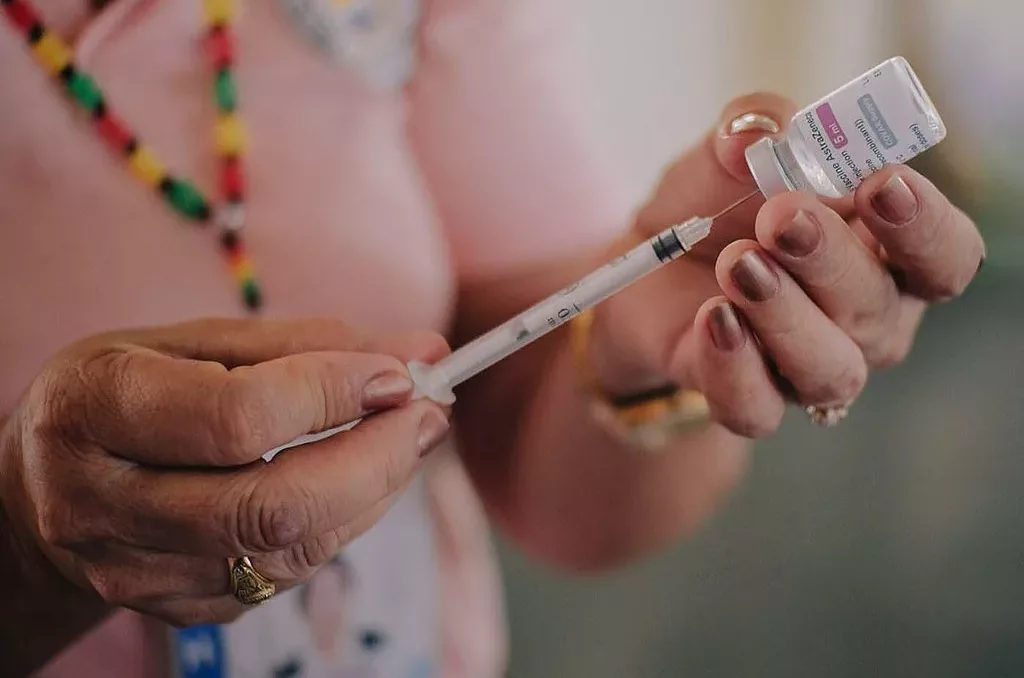The artist’s most recent sculpture in glass is a replica of the Oxford-AstraZeneca vaccine particle. The University of Oxford worked with pharmaceutical company AstraZeneca through the pandemic to develop one of the first vaccines. Image credit: Annalyn Gallego/Province of Camarines Sur, Public domain, via Wikimedia Commons
A model of the Oxford-AstraZeneca vaccine for Covid-19, a sculpture now on view at the History of Science Museum in Oxford City Centre, exists thanks in part to a curious coincidence.
In fact, the replica is only the most recent instalment in Glass Microbiology, a series on which the British visual artist Luke Jerram has been working since 2004. That was long before Covid exited the realm of science fiction and entered reality.
In those pre-pandemic times, Jerram had been surprised to learn that while viruses are usually coloured in scientific illustration, they are better described as transparent, since they are smaller than even the shortest wavelength of visible light. Keen to underscore the ethereal beauty of these particles as well as their danger, Jerram developed a collection of scale glass models of the infectious agents most relevant to modern medicine. The Microbiology series eventually came to feature not only viruses like HIV, but also larger pathogens like the Salmonella bacterium.
‘During my recovery from Covid-19, it became clear to me that my next artwork should focus on the way out of this global crisis’
Luke Jerram
SARS CoV-2 finally emerged in 2019. Jerram was soon commissioned by the Duke University School of Engineering in Durham, North Carolina (USA) to add the novel coronavirus to his lineup of replicas. Even in March 2020, however, when the sculpture was complete, no one could have predicted the scale of the pandemic that was then beginning.
After falling ill with Covid-19 in November 2020, right as the global quest for a vaccine was coming to a close, Jerram devised an optimistic twist for the series. ‘During my recovery,’ he reported, ‘it became clear to me that my next artwork should focus on the vaccine, our way out of this global crisis, as a tribute to the scientists and medical teams who have been working collaboratively across the world to fight the virus.’ He settled on a nanoparticle of the AstraZeneca vaccine and timed the release of the replica for February 2021, thereby marking the ten millionth Covid inoculation in the UK.
The real AstraZeneca nanoparticle is endowed with distinctive spike proteins that are functionally identical to those of SARS CoV-2. The vaccine thereby teaches the immune system to recognize and respond to the virus. At one million times the size of the nanoparticle, Jerram’s model still measures just 34 centimeters across its polyhedral body, creating a certain intimacy with the viewer. The entirety of its parts, including the filamentous mass of DNA at its core and the critical spike proteins on its surface, is custom-made from colourless borosilicate glass. By evoking the very laboratory equipment used to produce and deliver the vaccine, this material joins the explicit theme of the work in paying the tribute Jerram described.
The artist’s practice, which consists primarily of installations, is a favorite of scientific institutions worldwide, centered as it is on scientific communication and on global themes such as climate change. Now a visiting fellow in the Faculty of Health and Applied Sciences at the University of Bristol, Jerram produces the Microbiology series in collaboration with academic virologists, as well as with glassblowers trained by Pyrex.


Luke Jerram has produced a number of other microbiology-themed pieces in blown glass. Left, Amoeba sp., right, Escherichia coli, at the Museo delle Scienze (MUSE), Trento, Italy (2016). Image credit: Matteo de Stefano, MUSE, CC BY-SA 3.0, via Wikimedia Commons
Jerram first refines his plans for the sculptures with the virologists, whose own evolving understanding of their subject has been reflected in replicas over the years. He then oversees the assembly of the works by the glassblowers, who build each model according to a roughly consistent method. They begin with the DNA or RNA at the center of the particle, heating a thin glass rod and bending it according to specification. The strand is next inserted into a heated test tube, which expands while rotating on a lathe and is then clamped to form the casing of the genetic material. Glass details, often highly elaborate, are finally glued onto the exterior of this wall.
The display of the vaccine replica in Oxford, mere steps from where the actual inoculation was developed, is a first for Jerram’s series, parts of which have been exhibited as far away as Japan. Curious visitors should act quickly: the sculpture will be shown at the History of Science Museum only through June 2023.





